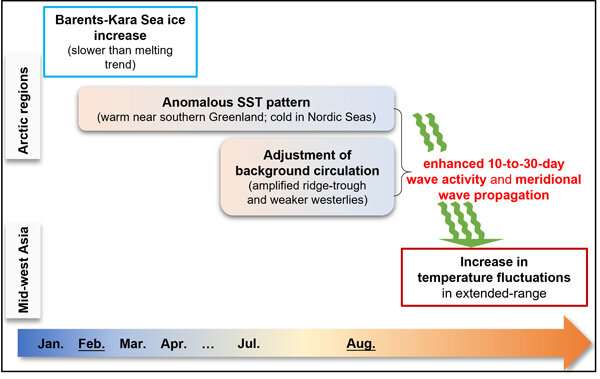This article has been reviewed according to Science X's editorial process and policies. Editors have highlighted the following attributes while ensuring the content's credibility:
fact-checked
peer-reviewed publication
trusted source
proofread
Cross-seasonal connection found between Arctic sea ice and Eurasian summertime temperature

In recent decades, the Arctic region has been experiencing noticeable warming and substantial sea ice loss. While research has shed light on the influence of the Arctic on mid-latitude weather and climate during winter, its impact on summertime conditions has received less attention and remains less understood. In this context, a research team from Nanjing University set out to investigate the relationship between changes in Arctic sea ice and summertime temperature fluctuations over Eurasia, along with potential underlying mechanisms.
The team adopted a novel approach, utilizing the essential part of local eddy available potential energy as a metric to quantify temperature fluctuations with different weather patterns on various timescales. Their findings reveal a significant cross-seasonal connection between strong or weak temperature fluctuations during the August 10-to-30-day period over mid-west Asia and corresponding fluctuations in the Barents-Kara Sea ice conditions from the previous February.
The research indicates that in years with enhanced Arctic sea ice, the 10-to-30-day atmospheric wave becomes more active in the North Atlantic–Barents-Kara Sea–Central Asia regions. Consequently, it manifests stronger southward propagation from the Barents-Kara Sea into the Ural region, leading to corresponding changes in the 10-to-30-day temperature fluctuations over the affected areas.
The study further suggests that persistent Arctic sea ice and subpolar Atlantic sea surface temperature anomalies from February to summer, along with background circulation transformation from July to August, may play key roles in driving these changes in atmospheric waves.
"This study emphasizes the significant role of 10-to-30-day atmospheric waves in connecting Arctic and mid-latitude climates," says corresponding author Prof. Yang Zhang from the school of Atmospheric Sciences, Nanjing University. "Moreover, it highlights that the influence of Arctic sea ice on summertime weather and climate differs from its impact on wintertime atmospheric circulations. This finding deserves greater attention and further systematic investigation in the future."
Prof. Yang Zhang also points out the relevance of their work to recent extreme heat events in the Eurasian continent during the summer. The team suggests that these events may be linked to the change in atmospheric wave activity with the sea ice loss in Arctic, which warrants further investigation.
The research, published in a special issue on Changing Arctic Climate and Low/Mid-latitudes Connections of the journal Advances in Atmospheric Sciences, contributes valuable insights into the intricate relationship between Arctic sea ice and Eurasian summertime temperature fluctuations. By delving into these connections, scientists are better equipped to understand the broader implications for climate patterns and variability in the future.
More information: Yanting Liu et al, A Cross-Seasonal Linkage between Arctic Sea Ice and Eurasian Summertime Temperature Fluctuations, Advances in Atmospheric Sciences (2023). DOI: 10.1007/s00376-023-2313-5
Journal information: Advances in Atmospheric Sciences
Provided by Chinese Academy of Sciences




















